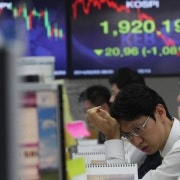Emerging market investing without the whiplash
Exchange traded funds (ETFs) in developed markets with good liquidity are powerful tools for investment.
But emerging market ETFs, as the last few weeks have shown, have resulted in huge outflows from markets where investing should be about patience. Emerging market ETFs fail to track the underlying index as accurately as in developing markets, and have underperformed the index by 16 per cent on a 5 year basis.
While we believe ETFs giving investors exposure to specialist sectors in developed markets are a useful investment tool, the converse is true when it comes to emerging and frontier markets.
Emerging and Frontier Markets investing requires a patient approach and the investor needs to be prepared to ride the periods of volatility. Closed-end funds give investors in Emerging and Frontier Markets a much more stable way to gain exposure to these markets as there is no need to sell underlying holdings if some investors sell their shares in the fund.
As importantly, and possibly more so on a global macroeconomic level, it is a much more responsible method of the developed world providing finance to the wider developing markets.”
The good.
ETFs in Developed Markets that abound with liquidity and can be accessed at a competitive price can be a good option for investors, although they offer no alpha. They can also offer accurate exposure to specialist sectors.
The bad.
The last few weeks have proven to be exceptionally turbulent for Emerging Markets and it is in these less liquid and more volatile markets where ETFs can both be detrimental for the markets they invest in and detrimental for investors.
Over the past three months, Emerging Market ETFs have lost 15.8 per cent of their assets*. Emerging Markets are volatile and should be a destination for patient investors’ capital. The fact that ETFs allow huge amounts of money to be pumped in and then rapidly withdrawn encourages a dangerous short-termist approach to these markets. It is also an extremely dangerous way for the developed world to finance the Emerging Markets which are dependent on patient support.
On top of this, the table above shows how a leading Emerging Markets ETF has underperformed the underlying Emerging Markets index by over 16 per cent on a total return basis over 5 years. This shows the difficulties that ETFs have in accurately tracking less liquid indices.
The ugly.
Frontier Markets have not suffered the rout that has been experienced by Emerging Markets over the last few weeks. The reason for this is a combination of a number of key factors. Importantly, there is much less ‘hot’ ETF money invested in Frontier Markets.
There is about US$300 billion of ETF money dedicated to Emerging Markets but only about US$500m dedicated to Frontier Markets. Secondly, a number of Frontier Markets currencies, especially a number of the MENA currencies, are pegged to the US dollar and are therefore unaffected by the US Federal Reserve’s tapering program.
However, there are a number of reasons for investors to be wary about Frontier Markets ETFs. The first is that, as with Emerging Markets ETFs, Frontier Markets ETFs tend to lag the underlying index more than in developed markets. Over a one year period alone, a leading Frontier Markets ETF lagged the MSCI Frontier Markets 100 by 1.9 per cent on a total return basis. This is even worse than the one year performance for a leading Emerging Markets ETF which underperformed the MSCI Emerging Markets Daily Net TR Index by almost 0.6 percent.
Secondly, the Frontier Index does not even give investors full exposure to the Frontier Markets. The index only gives investors exposure to 143 stocks in 26 countries whereas the actual investable frontier universe is over 7,000 stocks in 50 countries.
Thirdly, investors have to pay between 80-90bps to access the Frontier Markets ETFs which do not even offer the opportunity for alpha generation. This is a fact which seems to escape many retail investors.
Frontier market ETFs underperform their respective index but also only give investors exposure to half the investable countries. In frontier markets, investors also pay between 80-90bps to access Frontier Markets ETFs in return for no alpha generation.
As has been seen by the recent surge of funds out of Emerging Markets, ETFs are poor servants for both the emerging economies themselves and the investors looking to get exposure.
Leading ASX 200 ETF v ASX Accumulation 200 Index Leading EM ETF v MSCI Emerging Markets Daily Net TR Index |
| Total Return difference (%) for 5 year period ended 31/12/13 -4.73 -16.01 | ||||||||||||||||
* Source: TrimTabs
Dr Slim Feriani is CIO of Advance Emerging Capital, a London-based investment management company dedicated to global emerging and frontier growth markets equities.















